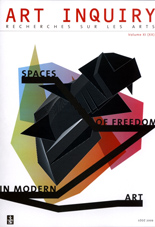Spaces of Freedom in Modern Art
Spaces of Freedom in Modern Art
Author(s): Grzegorz SztabińskiSubject(s): Fine Arts / Performing Arts
Published by: Łódzkie Towarzystwo Naukowe
Keywords: avant-garde; postmodernism; concepts of space; concepts of freedom
Summary/Abstract: Whenever the expression ‘spaces of freedom’ appears in a text about art, it is usually intended as a metaphor. In this article, the phrase is treated literally. To the avant-garde artists the search for new types of space was one of the most important goals. At the same time, they declared to aspire to freedom, albeit perceived in various ways. Could these goals be considered convergent or even connected? The text showcases three methods of approaching the discussed subject which occurred in the art of the 20th century. In the case of the first of these, the space of freedom is the function of human desires. The emergence of such an approach to the problem can be traced back to the Romantic subjectivisation of the manner in which space was presented; it was further developed by the avant-garde concepts, the discussion of which has been illustrated with examples of Futurism (the merging of the world and man), Surrealism (going beyond the ‘old oppositions’ in surreality) and Constructivism (freedom within an unlimited, homogeneous and uniform space). The second approach consists in treating human desires as the function of space. It appeared in art of the 1960s and 1970s, in two diverse forms. One of these varieties has been associated with accepting the urban space shaped by the consumer civilization (pop art), the other involved an exit to natural, secluded areas in order to search for freedom there (Land art). The final part of the article is entitled A Labyrinth as the space of freedom. A labyrinth contains an infinite number of equally ranked paths which one can follow, which evokes a sense of unrestricted liberty of choice but at the same time creates a prison. This situation has been discussed in reference to the postmodern concepts of creativity and perception, based on the examples of hyperspace in architecture and hypertext in media arts.
Journal: Art Inquiry
- Issue Year: 2009
- Issue No: 11
- Page Range: 91-122
- Page Count: 32
- Language: English

